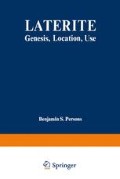Abstract
In 1800, while on a journey through Malabar and Kanara in present day India, Buchanan(1) reported on a material which could be cut “with a trowel or a large knife” and when exposed to air became hard. He called this an “indurate clay.” The material, which the natives called itica cullu, vettu cullu or kallu and meaning brick stone or cut stone, he named, from the Latin, laterite. meaning brick.
Access this chapter
Tax calculation will be finalised at checkout
Purchases are for personal use only
Preview
Unable to display preview. Download preview PDF.
Author information
Authors and Affiliations
Rights and permissions
Copyright information
© 1970 Plenum Press, New York
About this chapter
Cite this chapter
Persons, B.S. (1970). Genesis. In: Laterite. Monographs in Geoscience. Springer, Boston, MA. https://doi.org/10.1007/978-1-4684-7215-8_1
Download citation
DOI: https://doi.org/10.1007/978-1-4684-7215-8_1
Publisher Name: Springer, Boston, MA
Print ISBN: 978-1-4684-7217-2
Online ISBN: 978-1-4684-7215-8
eBook Packages: Springer Book Archive

